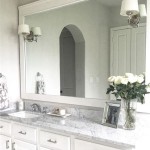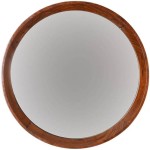How to Hang a Frameless Mirror with Wire
Frameless mirrors, with their sleek and minimalist aesthetic, can significantly enhance the visual appeal of any room. Their clean lines and absence of a frame allow them to blend seamlessly with various interior design styles, creating a sense of spaciousness and modernity. However, hanging a frameless mirror, especially one intended to be suspended by wire, requires careful planning, precise execution, and the appropriate tools to ensure both safety and a professional-looking result. This article provides a comprehensive guide on how to properly hang a frameless mirror using wire, covering the necessary preparations, installation steps, and important considerations for a successful project.
Before commencing the installation process, it is crucial to prioritize safety. Mirrors, being made of glass, are inherently fragile and heavy. Mishandling them can lead to breakage, resulting in potential injuries. Always wear appropriate safety gear, including gloves and eye protection, to minimize the risk of cuts or eye damage. Having a helper present is highly recommended, particularly for larger mirrors, as it makes the lifting and maneuvering process significantly easier and safer. Furthermore, ensure the work area is clear of any obstacles or hazards that could cause you to trip or lose balance.
Selecting the correct hardware and tools is paramount for a secure and aesthetically pleasing installation. The chosen wire, hanging hardware, and wall anchors must be capable of supporting the mirror's weight safely. Using undersized or inadequate components can lead to the mirror falling, causing damage to the mirror itself, the wall, and potentially causing serious injuries. Therefore, meticulous planning and selection of materials must precede the actual installation.
Determining Mirror Weight and Selecting Appropriate Hardware
The first step in preparing to hang a frameless mirror with wire is to accurately determine the mirror's weight. This information is essential for selecting the correct hanging hardware, including the wire, D-rings (or similar mounting brackets), and wall anchors. The weight of a mirror can vary significantly depending on its size, thickness, and the presence of any backing material. If the mirror's weight is not readily available from the manufacturer or seller, it can be estimated by calculating the volume of the glass and multiplying it by the density of glass, which is approximately 2.5 grams per cubic centimeter (or 156 pounds per cubic foot). However, a more accurate method is to weigh the mirror directly using a bathroom scale or a similar weighing device.
Once the mirror's weight is known, select a wire that is rated to hold at least two to three times that weight. This safety factor provides a margin of error and ensures that the wire will not break or stretch under the mirror's load. Picture hanging wire made of braided steel is a common and reliable choice. Determine the length of wire needed based on the desired hanging height and the distance between the mounting points on the back of the mirror. It is always advisable to overestimate the length of the wire slightly, as it is easier to trim excess wire than to add more.
Next, select appropriate D-rings or similar mounting brackets to attach the wire to the back of the mirror. These brackets should be made of sturdy metal and have a weight rating that matches or exceeds the wire's weight rating. The brackets should also be compatible with the method used to attach them to the mirror, which typically involves using a strong adhesive specifically designed for bonding metal to glass. Mirror mastic is a commonly used adhesive for this purpose.
Finally, choose appropriate wall anchors based on the wall's material (e.g., drywall, plaster, concrete) and the mirror's weight. Drywall anchors are available in various types, including self-drilling anchors, toggle bolts, and molly bolts. For heavier mirrors, toggle bolts or molly bolts are generally recommended, as they provide a more secure hold than self-drilling anchors. Concrete walls require the use of concrete screws or anchors specifically designed for use in masonry. Always consult the manufacturer's instructions for the chosen wall anchors to ensure they are installed correctly and can support the mirror's weight.
Attaching Mounting Hardware to the Mirror
The attachment of the D-rings (or similar mounting brackets) to the back of the frameless mirror requires precision and adherence to the manufacturer's instructions for the chosen adhesive. The placement of these brackets is critical for ensuring that the mirror hangs level and securely. Begin by cleaning the areas on the back of the mirror where the brackets will be attached. Use a clean cloth and a glass cleaner or degreaser to remove any dirt, dust, or fingerprints. This will ensure a strong bond between the adhesive and the glass.
Apply a generous amount of mirror mastic to the back of each D-ring, following the manufacturer's recommendations for the amount and application method. Press the D-rings firmly onto the cleaned areas on the back of the mirror, ensuring that they are aligned properly. The D-rings should be positioned symmetrically on either side of the mirror, at a distance that allows for the desired hanging height and the length of the wire. Use a level to ensure that the brackets are horizontally aligned.
Secure the D-rings in place with masking tape while the adhesive cures. The curing time for mirror mastic can vary depending on the product, but it typically takes at least 24 to 48 hours. Avoid moving or disturbing the mirror during this time, as this could weaken the bond. Once the adhesive has fully cured, carefully remove the masking tape.
After the adhesive has cured, inspect the D-rings to ensure they are securely attached. Gently try to wiggle or pull on the brackets to check for any signs of looseness. If any of the brackets are not securely attached, reapply adhesive and allow it to cure for the recommended time. It is crucial to ensure that all the brackets are firmly attached before proceeding with the next step.
Hanging the Mirror and Final Adjustments
With the mounting brackets securely attached to the mirror, the next step is to prepare the hanging wire. Cut a length of wire that is sufficient to span the distance between the D-rings and allow for some slack. Thread the wire through the D-rings, creating a loop. The wire should be threaded through the D-rings in a way that prevents it from slipping or sliding. Secure the wire by twisting the ends together tightly. Use pliers to crimp the twisted ends of the wire to prevent them from unraveling. Some individuals prefer to use wire crimps designed specifically for picture hanging wire to achieve a more secure and professional-looking connection.
Before hanging the mirror, locate and mark the desired position on the wall. Use a stud finder to identify any wall studs in the area. If possible, hang the mirror from a wall stud, as this will provide the strongest and most secure support. If a wall stud is not available, use appropriate wall anchors that are rated to support the mirror's weight. Install the wall anchors according to the manufacturer's instructions.
Carefully lift the mirror and position it against the wall, aligning the wire with the installed wall anchors. Ensure the wire is properly seated on the hooks or screws. Slowly release the mirror and check to see if it is hanging level. Use a level to make any necessary adjustments. If the mirror is not level, adjust the position of the wire on the wall anchors or the length of the wire between the D-rings.
Once the mirror is hanging level and securely, perform a final inspection. Ensure that the wire is not frayed or damaged and that the wall anchors are securely fastened to the wall. Gently tug on the mirror to test its stability. If the mirror feels unstable or the wall anchors appear to be pulling out of the wall, remove the mirror and reinforce the anchors or use heavier-duty anchors. After confirming the mirror is safely and securely hung, step back and admire the new addition to the space.

How To Hang A Mirror With Wire Pictures Wikihow

How To Hang A Mirror With Wire Pictures Wikihow

How To Hang A Frameless Mirror On The Wall With Pictures
How To Hang A 100 Pound Mirror On Drywall Quora

How To Hang A Frameless Mirror On The Wall With Pictures

How To Hang A Mirror With Wire Pictures Wikihow

How To Hang A Mirror With Wire Pictures Wikihow

How To Hang A Heavy Mirror With Pictures Wikihow

How To Install Wire On Back Of Mirror

How To Hang A Frameless Mirror On The Wall With Pictures








